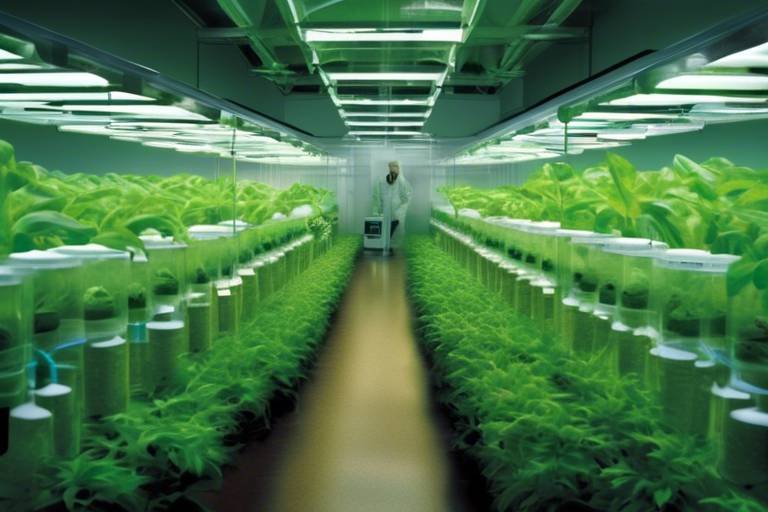Future Trends in Nanotechnology - Applications and Implications
As we stand on the brink of a new era, nanotechnology is emerging as a game-changer across various sectors. Imagine a world where materials are not only lighter and stronger but also smarter! The advancements in this field are not merely theoretical; they are reshaping our reality, pushing the boundaries of what we thought was possible. From healthcare to electronics, the implications of these innovations are profound, potentially altering our daily lives and the environment in ways we are just beginning to understand.
First off, let's talk about nanomaterials. These tiny materials, often measured in billionths of a meter, are revolutionizing industries by enhancing product performance and efficiency. Think of them as the secret ingredient in a recipe that takes a dish from ordinary to extraordinary. For instance, in construction, nanomaterials can create stronger and more durable materials, leading to buildings that can withstand natural disasters. In the automotive industry, lighter nanocomposites can improve fuel efficiency without compromising safety. The potential applications are vast, and the excitement surrounding these developments is palpable.
But it doesn't stop there. In the realm of medicine, nanotechnology is paving the way for groundbreaking advancements. Imagine being able to target a specific tumor with a drug that only affects cancer cells, leaving healthy cells unharmed. This is the promise of targeted drug delivery systems, which utilize nanoparticles to transport medication directly to affected areas in the body. By minimizing side effects and enhancing treatment efficacy, these systems are set to revolutionize cancer therapy and other medical treatments.
Moreover, the concept of personalized medicine is gaining traction, leveraging nanotechnology to tailor treatments based on individual patient profiles. This means that no two treatments are the same; they are customized to fit the unique genetic makeup of each patient. Such advancements not only improve health outcomes but also foster a deeper connection between patients and their healthcare providers. Imagine a world where your treatment is as unique as your fingerprint!
In addition to treatment, nanodiagnostics is making waves by employing nanoscale materials for early disease detection. Early diagnosis is crucial in managing diseases effectively, and these technologies are improving diagnostic accuracy and speed. Picture this: a simple blood test that can detect diseases at their nascent stage, leading to timely interventions. This is not just a dream; it's becoming a reality thanks to nanotechnology!
Now, let’s shift gears and consider the environmental implications. With the world facing severe ecological challenges, nanotechnology offers innovative solutions for pollution control and resource management. For instance, nanomaterials can be used to create filters that remove toxins from water, making it safe for consumption. Additionally, they play a crucial role in energy efficiency, helping to develop cleaner technologies that reduce our carbon footprint. The potential for sustainability is enormous, and as we harness these technologies, we move closer to a greener future.
The electronics industry is also witnessing a transformation due to nanotechnology. Imagine devices that are not only faster but also consume less energy. This is becoming a reality thanks to the development of nanoscale transistors. These tiny components are key to advancing computing power and miniaturization, enabling the creation of devices that are more powerful yet smaller than ever before. Think of your smartphone; with nanotechnology, it could soon be capable of performing tasks that currently require bulky computers!
Furthermore, nanotechnology is enhancing energy harvesting technologies, such as solar cells and batteries. By improving the efficiency of these systems, we can harness renewable energy more effectively, reducing our reliance on fossil fuels. Picture solar panels that capture more sunlight and convert it into energy, or batteries that charge faster and last longer. These advancements are not just beneficial; they are essential for a sustainable future.
- What is nanotechnology? Nanotechnology involves manipulating matter at the atomic or molecular scale to create materials with unique properties.
- How does nanotechnology impact healthcare? It enables targeted drug delivery, personalized medicine, and advanced diagnostic tools, improving patient outcomes significantly.
- Are there environmental benefits to nanotechnology? Yes, it offers solutions for pollution control and promotes sustainability through energy-efficient technologies.
- What are nanoscale transistors? These are tiny components that enhance the performance and efficiency of electronic devices, enabling faster computing.

Advancements in Nanomaterials
Recent innovations in nanomaterials are revolutionizing a variety of industries by creating products that are not only stronger but also lighter and more efficient. Imagine a world where materials are so advanced that they can enhance the performance of everyday items, from the clothes we wear to the devices we use. This is not just a dream; it's becoming a reality thanks to the continuous advancements in nanotechnology.
One of the most exciting developments in nanomaterials is the creation of nanocomposites. These materials combine nanoparticles with traditional substances to improve their properties significantly. For instance, adding carbon nanotubes to plastics can create a composite that is both lightweight and incredibly strong. This means that industries like automotive and aerospace can produce vehicles that consume less fuel while maintaining safety standards.
Moreover, nanomaterials are making waves in the field of energy storage and conversion. Take, for example, the advancements in lithium-ion batteries. By incorporating nanoscale materials, researchers are enhancing the battery's capacity and charging speed. This is crucial for the future of electric vehicles and renewable energy systems, as it directly impacts their efficiency and usability.
Another area where nanomaterials are proving to be game-changers is in coatings and surfaces. Nanotechnology allows for the development of coatings that are not only more durable but also possess unique properties such as self-cleaning and anti-bacterial effects. These coatings can be applied to various surfaces, including textiles and metals, making them resistant to stains and corrosion. Imagine a shirt that never gets dirty or a kitchen countertop that repels bacteria! This is the magic of nanotechnology at work.
In addition to these advancements, the field of biomedical applications is witnessing remarkable progress. Nanomaterials are being used to create scaffolds for tissue engineering, which can mimic the natural environment of cells. This innovation holds the potential to revolutionize organ transplants and regenerative medicine, providing hope for patients with severe injuries or degenerative diseases.
As we look to the future, the implications of these advancements in nanomaterials are vast. The potential applications span across various sectors, including construction, electronics, and even environmental sustainability. The versatility and adaptability of nanomaterials mean that they can be tailored to meet specific needs, paving the way for innovative solutions to some of the world's most pressing challenges.
In conclusion, the advancements in nanomaterials are not just incremental improvements; they represent a paradigm shift in how we approach material science. With ongoing research and development, we can expect to see even more groundbreaking applications that will shape our future in ways we can only begin to imagine.
- What are nanomaterials? Nanomaterials are materials that have structures at the nanoscale, typically between 1 to 100 nanometers. They exhibit unique properties that differ from their bulk counterparts.
- How are nanomaterials used in everyday products? Nanomaterials are used in a variety of products, including cosmetics, electronics, and medical devices, to enhance performance and durability.
- Are nanomaterials safe for the environment? While many nanomaterials are designed to be environmentally friendly, ongoing research is essential to assess their long-term impacts on health and the environment.

Nanotechnology in Medicine
Nanotechnology is truly revolutionizing healthcare in ways we could only dream of a few decades ago. Imagine a world where doctors can deliver medication directly to the cells that need it most, minimizing side effects and maximizing effectiveness. This isn't science fiction; it's happening now! The advancements in nanotechnology are paving the way for targeted drug delivery systems, personalized medicine, and cutting-edge diagnostic tools that are transforming patient care.
One of the most exciting applications of nanotechnology in medicine is the development of targeted drug delivery systems. These systems utilize nanoparticles—tiny particles that are just a few nanometers in size—to transport medication directly to the affected areas in the body. This method not only enhances the efficacy of treatments but also reduces the risk of side effects that often accompany traditional drug administration. For instance, instead of flooding the entire body with medication, which can affect healthy cells, nanoparticles can be engineered to release drugs in a controlled manner, ensuring that only the targeted area receives the treatment it needs.
Consider this: a patient suffering from cancer often endures harsh chemotherapy treatments that impact their entire body. However, with targeted drug delivery, nanoparticles can be designed to recognize and attach to cancer cells specifically. This precision medicine approach not only enhances treatment outcomes but also significantly improves the patient's quality of life during treatment. Imagine the relief of experiencing fewer side effects, all thanks to the power of nanotechnology!
Another groundbreaking aspect of nanotechnology is its role in personalized medicine. This approach tailors medical treatments to individual patient profiles, taking into account factors such as genetics, lifestyle, and specific health conditions. By utilizing nanoscale materials, doctors can create customized therapies that are more effective for each patient. For example, a drug that works wonders for one person may not have the same effect on another due to genetic differences. With nanotechnology, healthcare providers can analyze these differences and adjust treatments accordingly, leading to better health outcomes.
Moreover, we can't overlook the impact of nanodiagnostics in the medical field. These advanced diagnostic tools employ nanoscale materials to detect diseases at an early stage, often before symptoms even appear. Early detection is crucial in treating many health conditions, especially cancers and infectious diseases. By improving diagnostic accuracy and speed, nanotechnology enables timely interventions, which can be the difference between life and death for some patients. For instance, nanosensors can be used to identify biomarkers in a patient's blood, providing rapid results that allow for swift treatment decisions.
As we delve deeper into the world of nanotechnology, it's clear that its applications in medicine are not just about technological advancement; they are about transforming lives. From targeted therapies that minimize side effects to personalized treatments that cater to individual needs, the future of healthcare is looking brighter than ever. It's an exciting time for both patients and healthcare professionals as they embrace these innovations that promise to change the landscape of medicine forever.
- What is nanotechnology in medicine? Nanotechnology in medicine refers to the use of nanoscale materials and devices to improve healthcare outcomes, including drug delivery, diagnostics, and personalized treatments.
- How does targeted drug delivery work? Targeted drug delivery systems use nanoparticles to transport medications directly to specific cells or tissues, reducing side effects and increasing treatment effectiveness.
- What are the benefits of personalized medicine? Personalized medicine allows for tailored treatments based on individual patient profiles, leading to more effective therapies and improved health outcomes.
- How does nanodiagnostics improve disease detection? Nanodiagnostics utilizes nanoscale materials to detect diseases at an early stage, enhancing diagnostic accuracy and enabling timely interventions.

Targeted Drug Delivery Systems
Imagine a world where medicine is as precise as a sniper's aim, delivering treatment exactly where it's needed without affecting the surrounding healthy tissue. This is the promise of , a groundbreaking application of nanotechnology that is transforming healthcare. By utilizing nanoparticles—tiny particles that can be engineered to carry drugs directly to diseased cells—this innovative approach minimizes side effects and maximizes treatment efficacy.
At the core of these systems is the ability to modify the surface properties of nanoparticles, allowing them to recognize and bind to specific cells. This is akin to having a key that only fits one lock, ensuring that the medication is delivered precisely to the target area. For instance, cancer therapies can be designed to deliver chemotherapy drugs directly to tumor cells, sparing healthy cells from the often debilitating side effects of traditional treatments. Not only does this improve the patient's quality of life, but it also enhances the overall effectiveness of the treatment.
There are several types of nanoparticles used in targeted drug delivery, including:
- Liposomes: These are spherical vesicles that can encapsulate drugs and release them at targeted sites.
- Polymeric nanoparticles: Made from biocompatible materials, they can be designed to release drugs in response to specific stimuli.
- Gold nanoparticles: Known for their unique optical properties, they can be used for both drug delivery and imaging.
The implications of targeted drug delivery systems extend beyond just cancer treatment. For example, in treating autoimmune diseases, these systems can help deliver anti-inflammatory drugs directly to the affected areas, reducing systemic exposure and potential side effects. Furthermore, they hold promise in treating neurological disorders, where crossing the blood-brain barrier has historically posed a significant challenge. By engineering nanoparticles to navigate this barrier, researchers are opening the door to new therapies for conditions like Alzheimer’s and Parkinson’s disease.
As we look to the future, the integration of machine learning and artificial intelligence with targeted drug delivery systems is set to revolutionize personalized medicine. Algorithms can analyze patient data to predict which targeted therapies will be most effective based on individual genetic profiles. This level of customization not only improves patient outcomes but also paves the way for more efficient drug development processes.
In conclusion, targeted drug delivery systems represent a significant leap forward in medical treatment, providing a more effective and less harmful approach to delivering medication. As research continues to evolve, we can expect these systems to become a cornerstone of modern healthcare, offering hope and improved outcomes for patients worldwide.
What are targeted drug delivery systems?
Targeted drug delivery systems use nanoparticles to deliver medication directly to specific cells or tissues, enhancing treatment efficacy and minimizing side effects.
How do nanoparticles work in targeted drug delivery?
Nanoparticles can be engineered to recognize and bind to specific cells, allowing for precise delivery of drugs to the intended target area.
What types of diseases can benefit from targeted drug delivery?
Targeted drug delivery systems can be particularly beneficial for cancer treatments, autoimmune diseases, and neurological disorders, among others.
Will targeted drug delivery systems replace traditional medicine?
While targeted drug delivery systems offer significant advantages, they are likely to complement traditional medicine rather than completely replace it, providing more options for treatment.

Personalized Medicine
Imagine walking into a doctor's office and being greeted not just as a patient, but as a unique individual with a specific health profile. is making this a reality, thanks to the incredible advances in nanotechnology. This approach tailors medical treatments to the individual characteristics of each patient, which means that no two treatment plans are exactly alike. It’s like having a tailored suit versus an off-the-rack one; the fit is just right, and the results are often far superior.
At the heart of personalized medicine is the ability to analyze genetic, environmental, and lifestyle factors that contribute to a person's health. By utilizing nanotechnology, healthcare providers can gather precise data and create customized therapies that are more effective and have fewer side effects. For instance, nanoparticles can be engineered to deliver drugs directly to cancer cells, sparing healthy tissues and minimizing the harsh side effects typically associated with chemotherapy. This targeted approach not only enhances the efficacy of treatments but also significantly improves patients' quality of life.
Moreover, personalized medicine goes beyond just drug delivery. It encompasses a wide range of applications, including:
- Genomic Profiling: By sequencing a patient's genome, doctors can identify specific mutations that may respond to certain medications. This means that treatments can be chosen based on the genetic makeup of both the patient and the disease.
- Biomarker Discovery: Nanotechnology aids in the discovery of biomarkers—substances that indicate the presence of a disease. These biomarkers can guide treatment decisions and predict outcomes.
- Patient Monitoring: Advanced nanosensors can be used to monitor patients' health in real-time, allowing for adjustments in treatment plans as needed.
The implications of personalized medicine are profound. Not only does it promise to enhance treatment outcomes, but it also holds the potential to reduce healthcare costs by minimizing trial-and-error approaches in prescribing medications. In a world where healthcare is often one-size-fits-all, personalized medicine is a breath of fresh air, offering hope for more effective and individualized care.
In conclusion, as we continue to explore the capabilities of nanotechnology, the future of personalized medicine looks incredibly bright. It’s not just about treating diseases; it’s about understanding patients as unique individuals and providing them with the best possible care tailored specifically for them.
- What is personalized medicine? Personalized medicine is a medical model that tailors treatments to the individual characteristics of each patient, often using genetic information and advanced technologies.
- How does nanotechnology play a role in personalized medicine? Nanotechnology allows for the development of targeted drug delivery systems and advanced diagnostic tools, enhancing the effectiveness and safety of treatments.
- What are the benefits of personalized medicine? Benefits include improved treatment outcomes, reduced side effects, and lower healthcare costs due to more effective therapies.
- Is personalized medicine available to everyone? While personalized medicine is becoming more accessible, its application may vary based on specific health conditions and available technologies.

Nanodiagnostics
Nanodiagnostics is a groundbreaking field that harnesses the power of nanoscale materials to revolutionize how we detect diseases. Imagine having the ability to spot health issues at their very inception, almost like having a crystal ball for your health. This innovative approach employs nanoparticles that can interact with biological systems at a molecular level, providing unprecedented accuracy and speed in diagnostics.
One of the most exciting aspects of nanodiagnostics is its potential to significantly enhance early disease detection. Traditional diagnostic methods often rely on larger biological samples and can take time to yield results. In contrast, nanodiagnostics can analyze smaller samples, such as a drop of blood or a few cells, allowing for quicker and more efficient testing. This rapid response can be crucial in situations where time is of the essence, such as in the case of infectious diseases or cancer.
Furthermore, the technology behind nanodiagnostics is continually evolving. For instance, researchers are developing nanoparticles that can target specific biomarkers associated with diseases. This means that instead of a broad approach that may yield false positives or negatives, nanodiagnostics can provide a more tailored analysis. By focusing on the unique characteristics of a disease at the nanoscale, healthcare professionals can obtain clearer insights into a patient's condition.
To illustrate the incredible advancements in this field, consider the following table that highlights some common nanoscale materials used in diagnostics and their applications:
| Nanoscale Material | Application |
|---|---|
| Gold Nanoparticles | Used in assays for cancer biomarker detection due to their unique optical properties. |
| Quantum Dots | Fluorescent markers for imaging and tracking cellular processes in real-time. |
| Carbon Nanotubes | Utilized in biosensors for detecting pathogens and toxins with high sensitivity. |
Moreover, the implications of nanodiagnostics extend beyond individual health. As these technologies become more integrated into routine medical practice, they hold the promise of transforming public health strategies. Imagine a world where diseases are caught before they spread, where outbreaks are contained before they escalate. This proactive approach not only saves lives but also reduces healthcare costs significantly by minimizing the need for extensive treatments.
In summary, nanodiagnostics is not just a technological advancement; it’s a paradigm shift in how we approach health and disease management. With its ability to provide rapid, accurate, and targeted diagnostic capabilities, it is poised to play a critical role in the future of medicine. As we continue to explore and develop these nanoscale technologies, the potential for improved health outcomes becomes increasingly tangible, making it an exciting area for both researchers and patients alike.
- What is nanodiagnostics? Nanodiagnostics refers to the use of nanoscale materials for the early detection and diagnosis of diseases.
- How does nanodiagnostics improve disease detection? It allows for the analysis of smaller samples with greater accuracy and speed, leading to quicker results.
- What are some examples of nanoscale materials used in diagnostics? Common materials include gold nanoparticles, quantum dots, and carbon nanotubes, each serving specific diagnostic purposes.
- What are the benefits of early disease detection? Early detection can lead to timely interventions, lower healthcare costs, and improved patient outcomes.

Environmental Applications of Nanotechnology
As we stand at the crossroads of innovation and sustainability, nanotechnology emerges as a beacon of hope in addressing some of the most pressing environmental challenges of our time. Imagine a world where pollution is not just a problem but a challenge we can tackle head-on. With the advent of nanotechnology, this vision is becoming a reality. By manipulating materials at the atomic and molecular levels, we can create solutions that are not only effective but also environmentally friendly.
One of the most promising applications lies in pollution control. Nanomaterials, such as nanostructured catalysts, are being developed to enhance the efficiency of chemical reactions that break down pollutants. For instance, titanium dioxide nanoparticles are used in photocatalytic processes to decompose organic pollutants in water and air. This technology can significantly reduce harmful emissions from industrial sources, leading to cleaner air and water.
Additionally, nanotechnology plays a crucial role in resource management. Through the use of nanomaterials, we can improve the efficiency of resource extraction and waste management. For example, nanoscale membranes are being utilized in water purification systems, allowing for the removal of contaminants at a molecular level. This not only ensures access to clean drinking water but also minimizes the environmental impact of traditional filtration methods.
Moreover, nanotechnology is paving the way for advancements in renewable energy. Nanomaterials are being integrated into solar panels to increase their efficiency and reduce production costs. By enhancing light absorption and electron mobility, these nanoscale innovations allow solar cells to convert sunlight into energy more effectively. As a result, we are moving towards a future where renewable energy sources can meet a larger share of our energy needs.
To illustrate the impact of nanotechnology on environmental applications, the table below summarizes some key innovations and their benefits:
| Application | Nanotechnology Innovation | Environmental Benefit |
|---|---|---|
| Pollution Control | Nanostructured Catalysts | Enhanced breakdown of pollutants in air and water |
| Water Purification | Nanoscale Membranes | Improved removal of contaminants, ensuring clean water |
| Renewable Energy | Nanomaterials in Solar Cells | Increased efficiency and reduced costs of solar energy |
In conclusion, the environmental applications of nanotechnology are vast and varied, offering innovative solutions to pollution, resource management, and renewable energy challenges. As we continue to explore the potential of nanotechnology, we must remain mindful of its implications for the environment and strive for sustainable practices that benefit both humanity and the planet.
- What is nanotechnology? Nanotechnology is the manipulation of matter on an atomic or molecular scale, typically at dimensions between 1 and 100 nanometers.
- How does nanotechnology help the environment? It provides innovative solutions for pollution control, resource management, and renewable energy, improving efficiency and reducing environmental impact.
- Are there any risks associated with nanotechnology? While nanotechnology offers many benefits, there are potential risks related to toxicity and environmental impact that require careful assessment.

Nanotechnology in Electronics
In today's rapidly evolving technological landscape, nanotechnology is making waves, particularly in the electronics sector. Imagine a world where our devices are not only faster and more efficient but also smaller and lighter. This isn't just a futuristic dream; it's happening right now. With the integration of nanoscale materials and components, the electronics industry is undergoing a profound transformation that promises to reshape how we interact with technology in our daily lives.
One of the most exciting advancements is the development of nanoscale transistors. These tiny components are at the heart of modern electronics, enabling faster processing speeds and lower power consumption. Traditional transistors can only be miniaturized to a certain extent due to physical limitations, but nanotechnology breaks those barriers. By utilizing materials like graphene and carbon nanotubes, engineers are crafting transistors that are not only smaller but also significantly more efficient. This means your smartphone could potentially run applications that require immense processing power without draining the battery.
Moreover, the application of nanotechnology extends beyond just transistors. Energy harvesting technologies are also benefiting from these innovations. For instance, solar cells are being enhanced with nanomaterials that improve their efficiency. The incorporation of nanoparticles into solar panels allows for better light absorption and conversion, leading to more energy being harnessed from the sun. This is crucial as we strive for more sustainable energy solutions. Imagine a future where rooftops are not just for shelter but also serve as efficient power generators!
Additionally, batteries are undergoing a revolution thanks to nanotechnology. The development of nanostructured electrodes is paving the way for batteries that charge faster and last longer. This is particularly important for electric vehicles and portable electronics, where battery life is a significant concern. By using nanomaterials, we can increase the surface area of electrodes, leading to improved electrochemical reactions and, consequently, higher energy storage capacity.
But it's not just about performance; it's also about the impact on the environment. The push for energy-efficient devices means that less energy is consumed overall, which can lead to a reduction in carbon emissions. As more companies adopt nanotechnology in their manufacturing processes, we can expect to see a shift towards greener practices in the electronics industry.
As we look to the future, the implications of nanotechnology in electronics are profound. From faster computers to more efficient energy solutions, the potential is limitless. However, with these advancements come challenges, such as ensuring the safety and sustainability of nanomaterials. It's essential for researchers and manufacturers to address these concerns as they continue to innovate.
In summary, nanotechnology is not just a buzzword; it's a game changer in the electronics industry. The combination of nanoscale transistors, enhanced energy harvesting technologies, and innovative battery designs are setting the stage for a new era of electronics. As we embrace these advancements, we must also remain vigilant about their implications on society and the environment.
- What is nanotechnology? Nanotechnology refers to the manipulation of matter on an atomic or molecular scale, typically at dimensions between 1 and 100 nanometers.
- How does nanotechnology improve electronics? By enabling the development of smaller, faster, and more efficient components, nanotechnology enhances the performance and energy efficiency of electronic devices.
- Are there any environmental concerns with nanotechnology? Yes, while nanotechnology has the potential to improve sustainability, there are concerns regarding the safety and environmental impact of nanomaterials that need to be addressed.
- What future applications can we expect from nanotechnology in electronics? Future applications may include even more advanced computing systems, improved renewable energy solutions, and innovative consumer electronics that are more efficient and environmentally friendly.

Nanoscale Transistors
Nanoscale transistors are the backbone of modern electronics, enabling a leap in performance and miniaturization that was once thought impossible. As we venture deeper into the realm of nanotechnology, these tiny components are not just a trend; they are revolutionizing how we think about computing and electronic devices. Imagine a world where your smartphone is not only faster but also consumes less power and generates less heat—this is the promise of nanoscale transistors. With dimensions shrinking to a few nanometers, these transistors can switch on and off with incredible speed, significantly enhancing processing capabilities.
One of the most exciting aspects of nanoscale transistors is their ability to integrate more functionality into smaller spaces. Traditional transistors, which are already incredibly efficient, are being outperformed by their nanoscale counterparts. This transition allows for:
- Increased Density: More transistors can fit on a single chip, leading to greater computational power without increasing the physical size of devices.
- Lower Power Consumption: Nanoscale transistors require less energy to operate, making devices more efficient and prolonging battery life.
- Enhanced Performance: The speed at which these transistors can switch translates to faster processing times, which is crucial for applications in artificial intelligence and machine learning.
As we look ahead, the implications of nanoscale transistors extend beyond just consumer electronics. They are paving the way for advancements in various fields, including:
| Field | Application |
|---|---|
| Healthcare | Medical imaging and diagnostic devices that require rapid data processing. |
| Automotive | Advanced driver-assistance systems (ADAS) that rely on real-time data analysis. |
| Telecommunications | High-speed data transmission technologies that enhance connectivity. |
However, with great power comes great responsibility. The production of nanoscale transistors poses challenges, particularly concerning environmental impacts and material sustainability. As we strive for innovation, it is crucial to balance technological advancements with ecological considerations. Researchers are actively exploring ways to manufacture these components using sustainable materials and processes, ensuring that the future of electronics is not just advanced but also responsible.
In conclusion, nanoscale transistors are more than just tiny switches; they represent a paradigm shift in electronics, enabling smarter, faster, and more efficient devices. As the industry continues to innovate, we can expect these advancements to infiltrate every aspect of our lives, from the devices we use daily to the technologies that drive our economy. The future is indeed bright for nanoscale transistors, and the possibilities are as limitless as our imagination.
- What are nanoscale transistors?
Nanoscale transistors are miniature electronic switches that operate at a scale of nanometers, allowing for faster and more efficient processing in electronic devices. - How do nanoscale transistors improve device performance?
They increase the number of transistors on a chip, reduce power consumption, and enhance processing speed, leading to better overall performance. - What industries benefit from nanoscale transistors?
Industries such as healthcare, automotive, and telecommunications are significantly impacted by the advancements in nanoscale transistor technology. - Are there environmental concerns associated with nanoscale transistors?
Yes, the production and disposal of nanoscale transistors can pose environmental challenges, prompting research into sustainable manufacturing practices.

Energy Harvesting Technologies
In today's fast-paced world, the demand for sustainable energy solutions has never been greater. are stepping into the spotlight, utilizing nanotechnology to tap into renewable energy sources more efficiently than ever before. Imagine a world where your gadgets are powered not just by traditional batteries, but by the very environment around you—solar, thermal, and even kinetic energy. This is not just a dream; it's becoming a reality thanks to the advancements in nanotechnology.
One of the most exciting applications of nanotechnology in energy harvesting is in the development of nanostructured solar cells. These cells are made from materials engineered at the nanoscale, which significantly increases their surface area and light absorption capabilities. As a result, they can convert sunlight into electricity with greater efficiency than conventional solar panels. In fact, researchers are reporting efficiencies that could surpass 30%, which is a game-changer for both residential and commercial energy solutions.
Another area where nanotechnology is making waves is in thermoelectric materials. These materials can convert temperature differences into electrical energy. Imagine wearing a jacket that generates power from your body heat or using the heat from industrial processes to produce electricity. With the help of nanotechnology, these materials can be optimized for better performance, making them not just feasible but also practical for everyday use.
Moreover, the integration of nanomaterials in piezoelectric devices is leading to innovative energy harvesting solutions. These devices can generate electricity from mechanical stress, such as vibrations or movements. For instance, think about the potential of embedding piezoelectric materials in roads or sidewalks to harvest energy from the footsteps of pedestrians or the weight of vehicles. This could lead to a significant source of renewable energy, especially in urban areas.
Here's a quick look at some key benefits of energy harvesting technologies:
- Sustainability: These technologies harness energy from renewable sources, reducing reliance on fossil fuels.
- Cost-Effectiveness: Once implemented, energy harvesting systems can significantly lower energy bills and maintenance costs.
- Scalability: From small devices to large infrastructure, energy harvesting solutions can be tailored to fit various applications.
As we look to the future, the integration of nanotechnology in energy harvesting is poised to create a ripple effect across multiple sectors. Industries such as telecommunications, automotive, and even wearables are beginning to explore these technologies. For example, imagine a smartphone that charges itself using ambient light or a smartwatch that never needs to be plugged in because it harvests energy from your wrist movements. The possibilities are endless!
In conclusion, energy harvesting technologies powered by nanotechnology not only promise to enhance energy efficiency but also pave the way for a more sustainable future. As these innovations continue to evolve, they will play a crucial role in addressing global energy challenges, making our lives more convenient while protecting our planet.
- What are energy harvesting technologies?
Energy harvesting technologies capture and convert ambient energy from the environment into usable electrical energy. - How does nanotechnology enhance energy harvesting?
Nanotechnology improves the efficiency and performance of energy harvesting materials by manipulating them at the nanoscale, increasing their surface area and energy conversion capabilities. - What are some examples of energy harvesting technologies?
Examples include solar cells, thermoelectric generators, and piezoelectric devices that convert mechanical stress into electricity. - Are energy harvesting technologies cost-effective?
Yes, while the initial investment may be significant, the long-term savings on energy bills and maintenance make them cost-effective solutions.
Frequently Asked Questions
-
What is nanotechnology?
Nanotechnology is the manipulation of matter on an atomic or molecular scale, typically within the size range of 1 to 100 nanometers. It involves creating and utilizing materials and devices at this tiny scale to achieve unique properties and functionalities.
-
How is nanotechnology applied in medicine?
In medicine, nanotechnology is used for targeted drug delivery, allowing medications to be delivered directly to affected cells, minimizing side effects. It also plays a crucial role in nanodiagnostics, which enhances early disease detection and improves treatment outcomes.
-
What are the benefits of targeted drug delivery systems?
Targeted drug delivery systems increase treatment effectiveness by ensuring that drugs reach the precise location where they are needed. This approach reduces the risk of side effects and enhances the overall safety of treatments.
-
What is personalized medicine in the context of nanotechnology?
Personalized medicine tailors medical treatments to individual patient profiles, often using nanotechnology to analyze genetic and molecular information. This customization leads to more effective therapies and better health outcomes.
-
How does nanotechnology contribute to environmental sustainability?
Nanotechnology offers innovative solutions for environmental challenges, such as pollution control and resource management. For example, nanomaterials can be used to filter pollutants from water or improve the efficiency of renewable energy sources.
-
What impact does nanotechnology have on electronics?
Nanotechnology is transforming the electronics industry by enabling the development of smaller, faster, and more efficient devices. Nanoscale transistors and components enhance computing power and energy efficiency, paving the way for advanced electronic applications.
-
What are nanoscale transistors?
Nanoscale transistors are tiny electronic switches that operate at the nanoscale level. They are essential for improving the performance of electronic devices, enabling faster processing speeds and reduced energy consumption.
-
How is nanotechnology improving energy harvesting technologies?
Nanotechnology enhances energy harvesting technologies, such as solar cells and batteries, by improving their efficiency and performance. Nanoscale materials can increase surface area and optimize energy conversion processes, contributing to sustainable energy solutions.



















